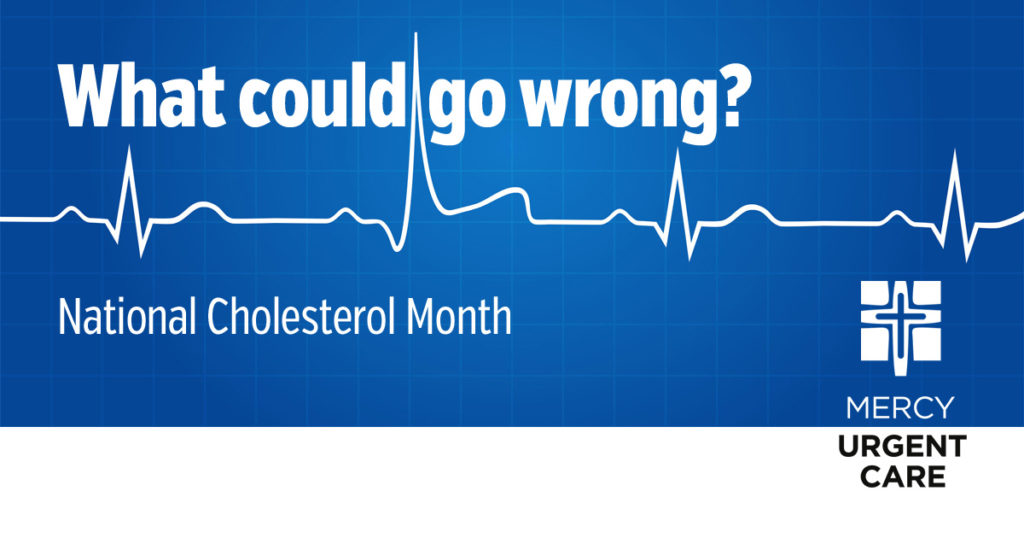
September is National Cholesterol Education Month. The healthcare providers at Mercy Urgent Care encourage you to stay healthy by having your cholesterol checked and taking steps to lower high cholesterol levels. By being conscious of your cholesterol levels, you can avoid being at risk of heart disease, which is the leading cause of death in the United States. Mercy Urgent Care hopes that everyone will make lifestyle changes to improve their overall heart health.
The Center for Disease Control provides the following information:
How many Americans have high cholesterol?
More than 102 million American Adults (20 years or older) have total cholesterol levels at or above 200 mg/dL, which is above healthy levels. More than 35 million of these people have levels of 240 mg/dL or higher, which puts them at high risk for heart disease.
What is cholesterol?
Cholesterol is a waxy, fat-like substance found in your body and many foods. Your body needs cholesterol to function normally and makes all that you need. Too much cholesterol can build up in your arteries. After a while, these deposits narrow your arteries, putting you at risk for heart disease and stroke.
How do you know if your cholesterol is high?
High cholesterol usually doesn’t have any symptoms. As a result, many people do not know that their cholesterol levels are too high. However, doctors can do a simple blood test to check your cholesterol. High cholesterol can be controlled through lifestyle changes or if it is not enough, through medications.
It’s important to check your cholesterol levels. High cholesterol is a major risk factor for heart disease, the leading cause of death in the United States.
How often should you have your cholesterol checked?
The National Cholesterol Education Program (NCEP) recommends that adults aged 20 years or older have their cholesterol checked every 5 years.
A simple blood test called a lipoprotein profile can measure your total cholesterol levels, including LDL (low-density lipoprotein, or “bad” cholesterol), HDL (high-density lipoprotein, or “good” cholesterol), and triglycerides.
The following chart shows optimal lipid levels for adults:
Desirable Cholesterol Levels |
|
| Total cholesterol | Less than 170 mg/dL |
| Low LDL (“bad”) cholesterol | Less than 110 mg/dL |
| High HDL (“good”) cholesterol | 35 mg/dL or higher |
| Triglycerides | Less than 150 mg/dL |
The National Cholesterol Education Program has developed specific recommendations about cholesterol treatment for people at increased risk, such as those with a family history of high cholesterol or heart disease.
If you have high cholesterol, what can you do to lower it?
Your doctor may prescribe medications to treat your high cholesterol.5 In addition, you can lower your cholesterol levels through lifestyle changes:
- Low-fat and high-fiber food (Eat more fresh fruits, fresh vegetables, and whole grains).
- For adults, getting at least 2 hours and 30 minutes of moderate or 1 hour and 15 minutes of vigorous physical activity a week. For those aged 6-17, getting 1 hour or more of physical activity each day.
- Maintain a healthy weight.
- Don’t smoke or quit if you smoke.
Cholesterol Resources:
- CDC’s Cholesterol Web Site
- Cholesterol Fact Sheet
- State Heart Disease and Stroke Prevention Programs Address High Blood Cholesterol
- Cholesterol Education Month Web Site of the National Heart, Lung, and Blood Institute
- National Cholesterol Education Program
- The American Heart Association
Mercy Urgent Care is the only dedicated not-for-profit urgent care network in Western North Carolina, providing an alternative to hospital emergency rooms for the treatment of non-life-threatening illness and injury.

